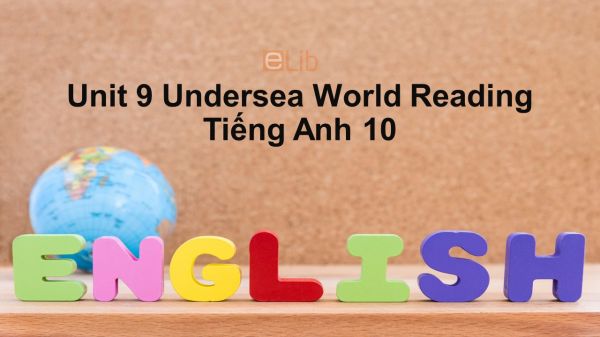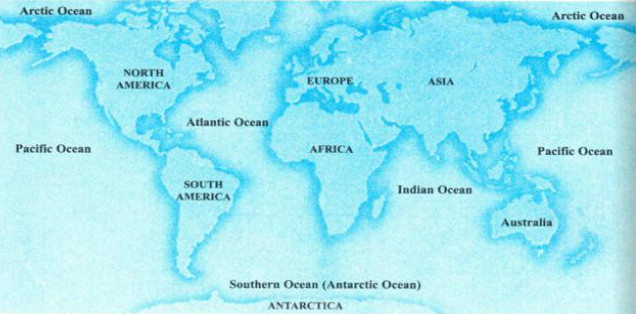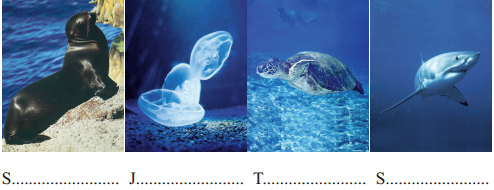Unit 9 lớp 10: Undersea world-Reading
Bài học Unit 9 lớp 10 "Undersea world" phần Reading hướng dẫn các em đọc hiểu đề tài về thế giới dưới lòng đại dương. Qua bài học hy vọng giúp các em mở rộng thêm vốn hiểu biết và kỹ năng cho mình.
Mục lục nội dung

Unit 9 lớp 10: Undersea world-Reading
1. Before You Read Unit 9 lớp 10
Work with a partner. Look at map and give the Vietnamese names for the oceans on the map (Làm việc với một bạn cùng học. Nhìn bản đồ và viết tên những đại dương trên bản đồ bằng tiếng Việt)
Map
Guide to answer
Arctic Ocean
Pacific Ocean
Atlantic Ocean
Indian Ocean
Antarctic Ocean
Tạm dịch:
Arctic Ocean: Bắc Băng dương
Pacific Ocean: Thái Bình dương
Atlantic Ocean: Đại Tây dương
Indian Ocean : Ấn Độ dương
Antarctic Ocean: Nam Băng dương
Work with a partner: Look at the pictures below Can you name the sea animal in each picture? The firsl letter of the word has been given to help you (Làm việc với một bạn cùng học. Nhìn các hình bên dưới. Bạn có thể gọi tên động vật biển ở mỗi hình không. Mẫu tự được cho để giúp em)

Unit 9: Undersea world - Reading
Guide to answer
Seal Jellyfish
Turtle Shark
Tạm dịch:
Seal: hải cẩu Jellyfish: con sứa
Turtle:rùa biển Shark : Cá mập
2. While You Read Unit 9 lớp 10
Read the text and do the tasks that follow (Đọc đoạn văn và làm bài tập theo sau)
There is only one ocean. It is divided into five different parts: the Pacific, Atlantic, Indian, Antarctic, and Arctic Oceans. There are also many other smaller seas, gulfs and bays which form part of them. Altogether they cover 75 percent of the earth's surface. For centuries, people have been challenged by the mysteries that lie beneath the ocean. However, today's scientists have overcome many of the challenges of the depth by using modern devices. They send submarines to investigate the seabed and bring samples of marine life back to the surface for further study. Satellite photographs provide a wide range of information, including water temperature, depth and the undersea populations. If modem technology did not exist, we would never have such precious information.
Marine plants and animals fall into three major groups. Some of them live on or depend on the bottom like the starfish. Some are swimming animals such as fishes and sharks that move independently of water currents while others are tiny organisms that are carried along by the currents like the jellyfish. Plants and animals of the sea, however small or oversized, all contribute to its biodiversity. Unless this biodiversity were maintained, marine life would be at stake.
Tạm dịch
Chỉ có một đại dương duy nhất. Nó được chia thành năm phần khác nhau: Thái Bình Dương, Đại Tây Dương, Ấn Độ Dương, Nam Băng Dương và Bắc Băng Dương. Cũng còn có nhiều biển, vùng, vịnh nhỏ hơn là một phần của các đại dương ấy. Những đại dương này chiếm 75% bề mặt trái đất. Nhiều thế kỷ nay những bí mật nằm sâu dưới lòng đại dương đã thách thức con người. Tuy nhiên, các nhà khoa học hiện nay với các trang thiết bị hiện đại đã vượt qua được những thách thức của đại dương. Con người đưa tàu ngầm đi khảo sát đáy biển và đưa lên bờ những mẫu sinh vật biển để nghiên cứu thêm. Những bức ảnh chụp từ vệ tinh cung cấp rất nhiều thông tin, bao gồm nhiệt độ nước biển, độ sâu và các cư dân dưới biển. Nếu không có những công nghệ hiện đại, chúng ta sẽ chẳng bao giờ có những thông tin quí giá như thế.
Động, thực vật biển được chia thành ba nhóm chính. Nhóm sống nhờ và lệ thuộc vào tầng đáy như loài sao biển. Nhóm động vật bơi như các loài cá và cá mập di chuyển không phụ thuộc vào dòng nước trong khi các loài sinh vật nhỏ bé khác bị dòng nước cuốn trôi đi như loài sứa biển. Động thực vật biển dù có kích thước nhỏ bé hay to quá cỡ đều góp phần vào sự đa dạng sinh học của biển. Nếu sự đa dạng sinh học này không được duy trì, sinh vật biển sẽ bị đe dọa.
2.1. Task 1 Unit 9 lớp 10
The words in the box all appear in the passage. Fill in each blank with one of them. There are more words than needed (Các từ trong khung xuất hiện ở bài đọc. Điền mỗi chỗ trống với một trong chúng. Có nhiều từ hơn cần thiết)
1. Some plants and animals are referred to as________ organisms because they are extremely small.
2. Thanks to modern technology, scientists have been able to________ the life of plants and animals that live under the sea.
3. A ________ is a large area of sea that is partly surrounded by land.
4. ________ is a term that refers to the existence of different kinds of animals and plants which make a balanced environment.
5. These scientists have collected different________ to analyse for their experiment.
Guide to answer
1. tiny 2. investigate 3. gulf
4. biodiversity 5. samples
Tạm dịch
1. Một số thực vật và động vật được gọi là sinh vật nhỏ vì chúng cực kỳ nhỏ.
2. Nhờ công nghệ hiện đại, các nhà khoa học đã có thể điều tra cuộc sống của thực vật và động vật sống dưới biển.
3. Vịnh là một khu vực rộng lớn của biển được bao bọc một phần bởi đất liền.
4. Đa dạng sinh học là một thuật ngữ đề cập đến sự tồn tại của các loại động vật và thực vật khác nhau tạo nên một môi trường cân bằng.
5. Các nhà khoa học này đã thu thập các mẫu khác nhau để phân tích cho thí nghiệm của họ.
2.2 Task 2 Unit 9 lớp 10
Read the passage again and then answer the following questions (Đọc lại đoạn văn và trả lời các câu hỏi sau)
1. What percentage of the earth's surface is covered by seas and oceans?
2. How do scientists now overcome the challenges of the depth?
3. What can submarines do to help scientists know about the undersea world?
4. What can we learn from the satellite photos?
5. What are the three groups of marine plants and animal?
6. What would happen if the sea biodiversity were not maintained?
Guide to answer
1. 75% of the earth’surface is covered by sea and oceans.
2. They now overcome the challenges of the depth by using modern devices.
3. They investigate the seabed and bring samples of the marine life back to the surface for further study.
4. We can know a wide range of information, including water temperature, depth and the undersea population.
5. They are those that live on or depend on the bottom like the starfish, those that move independently of water currents and those that are carried along by the currents
6. The marine life would be at stake if the sea bioadversily was not maintained.
Tạm dịch
1. Phần trăm bề mặt trái đất được bao phủ bởi biển và đại dương là bao nhiêu?
75% bề mặt trái đất được bao phủ bởi biển và đại dương.
2. Làm thế nào để các nhà khoa học vượt qua những thách thức của chiều sâu?
Bây giờ họ vượt qua những thách thức của chiều sâu bằng cách sử dụng các thiết bị hiện đại.
3. Tàu ngầm có thể làm gì để giúp các nhà khoa học biết về thế giới dưới đáy biển?
Chúng điều tra đáy biển và đưa các mẫu sinh vật biển trở lại bề mặt để nghiên cứu sâu hơn.
4. Chúng ta có thể biết được gì từ các bức ảnh vệ tinh?
Chúng ta có thể biết nhiều thông tin, bao gồm nhiệt độ nước, độ sâu và dân số dưới đáy biển.
5. Ba nhóm thực vật và động vật biển là gì?
Chúng là những thứ sống trên hoặc phụ thuộc vào đáy biển như con sao biển, những thứ di chuyển độc lập với dòng nước và được mang theo bởi dòng chảy
6. Điều gì sẽ xảy ra nếu đa dạng sinh học biển không được duy trì?
Các sinh vật biển sẽ bị đe dọa nếu sinh học biển không được duy trì.
3. After You Read Unit 9 lớp 10
Work in pairs. Complete the summary of the reading passage by filling in each blank with a word or phrase given in the box below (Làm việc từng đôi. Điền bài tóm tắt của bài đọc bằng cách điền mỗi chỗ trống với từ hoặc cụm từ được cho trong khung bên dưới)
Though covering (1)_______ of the earth's surface, the ocean has remained (2) _______ to us until recently. With (3)_______ technology we have now made important (4)_______ about the (5)_______ of marine lira
We have learnt that whether tiny or (6)_______ , all the (7)_______ of the sea are (8)_______ .
Guide to answer
1. three-quarters 2. mysterious 3. modern
4. discoveries 5. biodiversity 6. huge
7. plants and animals 8. closely connected
Tạm dịch:
Mặc dù bao phủ ba phần tư bề mặt trái đất, đại dương vẫn còn bí ẩn đối với chúng ta cho đến gần đây. Với công nghệ hiện đại, chúng ta đã có những khám phá quan trọng về đa dạng sinh học của sinh vật biển. Chúng ta đã biết được rằng dù nhỏ hay to, tất cả các loài thực vật và động vật biển đều được kết nối chặt chẽ.
4. Pratice
4.1. Reading comprehension
Read the passage carefully, then choose the correct answer - a, b, c, or d (Đọc đoạn văn cẩn thận và chọn câu trả lời đúng)
Most people are afraid of sharks, but they usually do not know much about them. For example, there are about 350 species of sharks that live in oceans over the world. All of the sharks are carnivores, but most of them don't attack people. Some sharks are very small - the smallest shark is about 6 inches long - about as long as your hand. But some sharks are very large. The largest species of sharks may be 60 feet long and weigh 15 tons. Unlike many other kinds of fish, sharks do not have bone. Their bodies are made up of a kind of tough white flexible material (called cartilage). Sharks do not have ears. However, they 'hear' sounds and movements in the wade. Any sound or movement makes the water vibrates. Sharks can feel these vibrations and they help the sharks find food. Sharks use their large eyes to find food, too. Most sharks see best in low light. They often hunt for food at dawn. in the evening, or in the middle of the night.
Nowadays scientists want to learn more about sharks for several reasons. For example, cancer is common in many animals, including, people. However. it is rare in sharks. Scientists want to find out why sharks almost never get cancer. Maybe this information can help people prevent cancer too.
1. According to the passage, sharks.........................
a. are big mammals. b. usually live in warm water.
c. are meat eaters. d. always attack humans.
2. How long is a smallest shark?
a. About 6 centimeters b. As long as a hand
c. As one's long hand d. About 1,5 meters
3. The word 'they' in line 11 refers to..........................
a. sharks b. sounds c. vibrations d. movements
4. Sharks can hunt for food at night because .............................
a. they 'hear' more clearly at night. b. their eyes are large.
c. they feel vibrations in the water. d. they see well in the dark.
5. Which of the following is not true?
a. Large sharks can weigh up to 15,000 kg. b. Sharks' bodies are made up of cartilage.
c. Sharks can find their food by feeling vibrations. d. Sharks often attack people.
6. It can be inferred from the last paragraph that ...............................
a. sharks are being studied.
b. the cancer risk among animals is found to be higher.
c. scientists are given permission to catch sharks for their studies.
d. information about sharks help people cure cancer.
4.2. Multiple-choice
Để nâng cao kĩ năng đọc hiểu với chủ đề "Undersea world", mời các em đến với bài trắc nghiệm Unit 9 Reading Tiếng Anh 10 sau đây và cùng luyện tập.
5. Conclusion
Qua bài học này các em phải ghi nhớ các từ vựng quan trọng như sau
- undersea ['ʌndəsi:] (adj): dưới mặt biển
- ocean ['əʊ∫n] (n): đại dương, biển
- Pacific Ocean [pə'sifik'ou∫n] (n): Thái Bình Dương
- Atlantic Ocean [ət'læntik'ou∫n] (n): Đại Tây Dương
- Indian Ocean ['indjən'ou∫n] (n): Ấn Độ Dương
- Antarctic [æn'tɑ:ktik](adj) (thuộc): Nam Cực
- Antarctic Ocean (n): Nam Băng Dương
- Arctic ['ɑ:ktik] (adj): (thuộc) Bắc Cực
- Arctic Ocean (n): Bắc Băng Dương
- gulf [gʌlf] (n): vịnh
- percentage [pə'sentidʒ] (n): tỷ lệ
- =mystery ['mistəri] (n) điều huyền bí, điều thần bí
- mysterious (adj): kỳ bí
- beneath [bi'ni:θ] (prep): ở dưới, thấp kém
- overcome [,ouvə'kʌm] (v) -overcame- overcome: thắng, chiến thắng
- depth [depθ] (n): chiều sâu, bề sâu.
- submarine [,sʌbmə'ri:n] (n): (hàng hải) tàu ngầm
- investigate [in'vestigeit] (v): khám phá
- seabed ['si:'bed] (n): đáy biển
- sample ['sɑ:mpl] (n): mẫu; vật mẫu
- marine [mə'ri:n] (adj): (thuộc) biển; gần biển
- satellite ['sætəlait] (n): vệ tinh
- exist [ig'zist] (v)đã sống; tồn tại
- existence [ig'zistəns] (n): sự tiếp tục cuộc sống; sự sống sót
- precious ['pre∫əs] (adj): quý, quý giá, quý báu
- fall into…(v): được chia thành
- bottom ['bɔtəm] (n): phần dưới cùng; đáy; đáy biển.
- starfish ['stɑ:fi∫] (n): (số nhiều: starfish) sao biển
- shark [∫ɑ:k] (n) cá mập
- man-eating shark: cá mập trắng
- organism ['ɔ:gənizm] (n): cơ thể; sinh vật
- carry along (v): cuốn theo
- jellyfish ['dʒelifi∫] (n): con sứa
- oversized ['ouvəsaizd] (adj): quá khổ, ngoại khổ
- contribute [kən'tribju:t] (v): đóng góp, góp phần
- biodiversity [,baioui dai'və:siti] (n): đa dạng sinh học
- maintain [mein'tein] (v): duy trì
- at stake: thua, đang lâm nguy, đang bị đe doạ
- refer [ri'fə:] to (v): quy, quy vào
- balanced ['bælənst] (adj): cân bằng, ổn định
- analyse ['ænəlaiz] (v): phân tích
- experiment [iks'periment] (n): cuộc thí nghiệm



